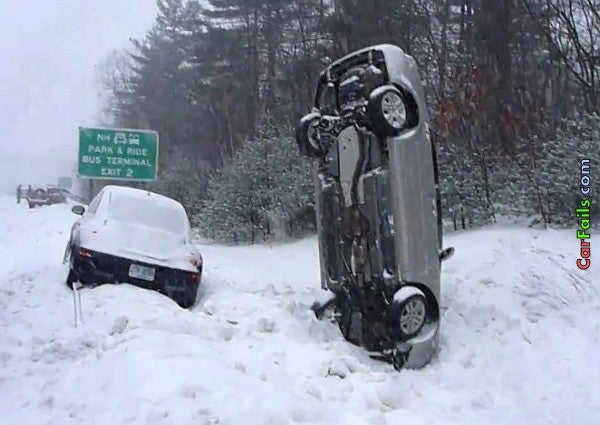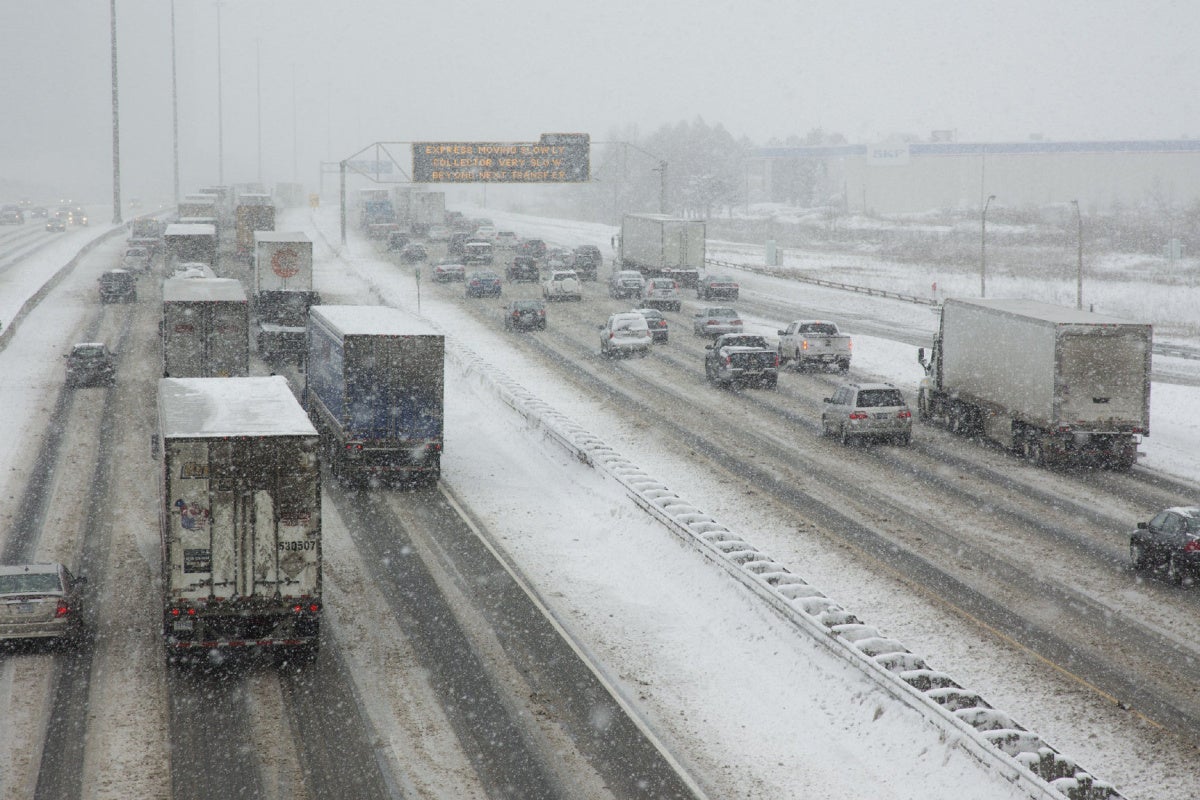 "Frank Grimes" (FrankGrimes)
"Frank Grimes" (FrankGrimes)
12/09/2016 at 03:00 ē Filed to: None
 1
1
 14
14
 "Frank Grimes" (FrankGrimes)
"Frank Grimes" (FrankGrimes)
12/09/2016 at 03:00 ē Filed to: None |  1 1
|  14 14 |
If i were to head out into the snow to learn to drive better and didnít want to just mess around trying to figure things out on my own is there a book I could read or a certain technique or routine I should focus on so I can see improvement?
If I were president I would make skid pans available to all public so they can practice driving in a safe place. Also it might have a drag strip too.

 jimz
> Frank Grimes
jimz
> Frank Grimes
12/09/2016 at 03:31 |
|
winter tires.
Period.
 AMGtech - now with more recalls!
> Frank Grimes
AMGtech - now with more recalls!
> Frank Grimes
12/09/2016 at 03:58 |
|
Cut your speed in half. Every little movement you make should be done as smoothly and gently as possible. Keep brake and throttle inputs to a minimum. Allow yourself extra space between yourself and everyone/everything else. find an empty parking lot or something, do a few panic stops and slow speed skids to get a feel for what it takes to break traction and just how slick the roads are.
 TheD0k_2many toys 2little time
> Frank Grimes
TheD0k_2many toys 2little time
> Frank Grimes
12/09/2016 at 04:11 |
|
practice in a large open lot.
 VonBootWilly - Likes Toyota, but it's still complicated.
> jimz
VonBootWilly - Likes Toyota, but it's still complicated.
> jimz
12/09/2016 at 04:32 |
|
Also mantained brakes. Sticky calipers are like somebody pulling your handbrake when you donít expect it.
 pip bip - choose Corrour
> Frank Grimes
pip bip - choose Corrour
> Frank Grimes
12/09/2016 at 06:36 |
|
as someone whoís never driven a lot in snow. we only get an odd snow day every few years here, iíd probably end up like that car on itís nose.
 PartyPooper2012
> Frank Grimes
PartyPooper2012
> Frank Grimes
12/09/2016 at 06:54 |
|
That built up snow area between left wheels and right wheels on the road - thatís like an involuntary brake for side of the car that hits it. When you switch lanes, wheels on one side will hit it and make that side of the car go slower. Use extra caution, go slow, and pay attention. No sudden movements to the steering wheel or brakes or accelerator. Just... go with the flow.

 Comes over to help work on your car and only drinks beer
> Frank Grimes
Comes over to help work on your car and only drinks beer
> Frank Grimes
12/09/2016 at 07:48 |
|
As at least one other has said, a large, empty parking lot is good if you can find one before itís plowed, otherwise, one thing to help you think, pretend like you have an egg between your foot and the accelerator/brake. Just as in wet conditions, only amplified, sliding friction is less than rolling friction, so once you lose traction, itís hard to get it back. The Ďeggí teaches you to be soft on the pedals, keeping you in rolling friction. If youíve lived in snowy climates before, weíve all seen the person with it floored, spinning their wheels like crazy, only barely moving forward and having no steering whatsoever if itís a front wheel drive vehicle. If they got off the gas, let the car start under idle, then gently add pedal without losing traction, theyíd be much better off. The same concept applies to steering as well, but the Ďeggí thinking doesnít translate. You need to be very gentle with all of the driver inputs. Again, keep the wheels rolling and not sliding, or youíre going to lose positive control. The thing about braking, yes you need to be light on the pedal, but you need to be thinking of that before you need to use it. Let off the gas earlier than you would, and apply lighter brake, which means you need to be doing that sooner than you normally would.
 Tripper
> Frank Grimes
Tripper
> Frank Grimes
12/09/2016 at 08:26 |
|
I always like to hoon around in a parking lot after the first snow of the year. Especially if Iíve got a car that I have not driven in snow before/a new set of tires. Itís good to know how the car will handle and how it feels right before the wheels break into a slide. Once you do slide you can recover in a panic free environment. Doing all of that is also really fun, so there is that too!
 Wrong Wheel Drive (41%)
> Frank Grimes
Wrong Wheel Drive (41%)
> Frank Grimes
12/09/2016 at 09:07 |
|
When in doubt, power out!
 BKosher84
> jimz
BKosher84
> jimz
12/09/2016 at 09:16 |
|

 functionoverfashion
> Frank Grimes
functionoverfashion
> Frank Grimes
12/09/2016 at 09:19 |
|
I remember that picture when it happened, it wasnít too far from where I live so of course, it was all over the news. Itís pretty amazing, really.
On topic: I donít know of any books, but if you can make it up to a place like Team OíNeil, they do a winter driving clinic that you can take with your own car, so you really get to learn about its limits and how to handle it beyond its limits, in a very safe environment. Something like that is probably the best possible answer, but it involves spending money and being in Dalton, New Hampshire for the weekend. At least you can hang out in Littleton, which is a nice town right nearby. Schilling Brewery is excellent... but I digress.
In any case, messing around in an empty parking lot will teach you a lot. Thatís what I keep saying when I do it every single time it snows and Iíve been driving in snow for 20 years.
 red014
> Frank Grimes
red014
> Frank Grimes
12/09/2016 at 09:25 |
|
No quick inputs. No stabbing the throttle or brakes, no yanking the steering wheel. I learned my carís limits by hooning in an un-plowed parking lot. Sure it might get you in trouble if you get caught, but you learn what your car can and canít do.
 gmctavish needs more space
> Frank Grimes
gmctavish needs more space
> Frank Grimes
12/09/2016 at 10:25 |
|
The first thing I do with a new vehicle or different tires in the snow/slush is find an empty road or parking lot and see where the limits are at. See where it loses grip accelerating, turning, and how quickly I can stop. If itís icy, same thing, but you can safely assume all of grip those thresholds will be significantly lower on ice. the braking distance is most important imho, see how much room you need to leave to stop, and then leave even more room.
 vicali
> Frank Grimes
vicali
> Frank Grimes
12/09/2016 at 11:38 |
|
Find a parking lot or a nice empty road with lots of space/run off.. practice your oversteer/understeer, brake, stoping until you are comfortable with how your car feels.
Get winter tires. It is a lot more fun doing tail-outs on purpose than by accident.